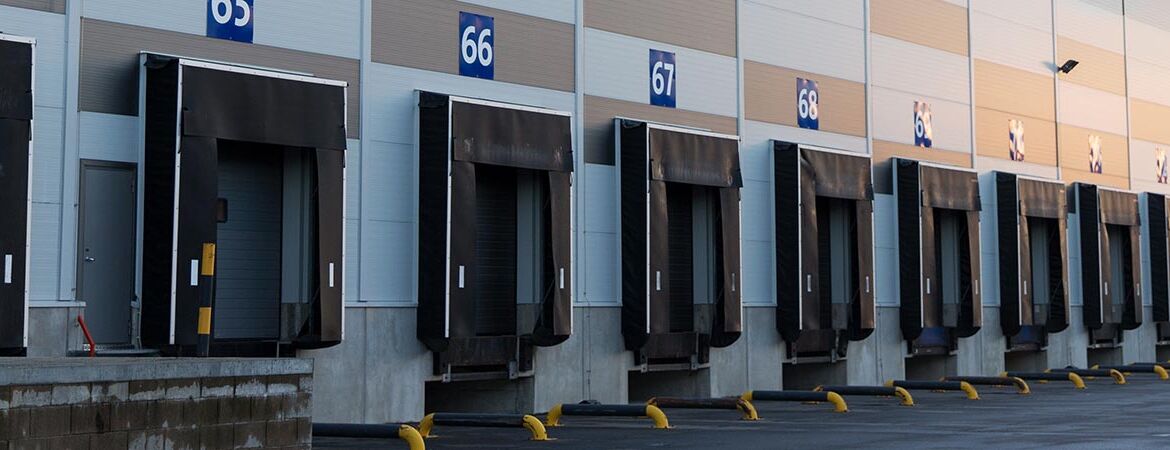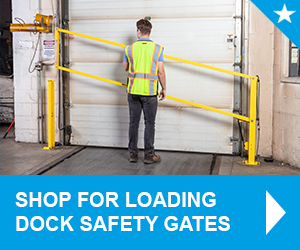
For some leaders, loading dock safety can be an ever-present concern, because no other point in a facility involves a greater intersection of moving parts, whether that’s mobile equipment or competing worker needs. With a near-endless potential for safety violations – and worse, workplace injuries – it’s essential to consistently take the initiative to improve warehouse dock safety.
To help make the job easier, we have collected five techniques that safety managers like you can adopt in your facility and describe how the right equipment can keep workers safe—and keep your loading dock compliant with OSHA fall protection standards.
A Magnet for Activity
As the main hub of activity in a warehouse, loading docks are prime areas for workflow bottlenecks. Almost anything that daily operations depend on passes through them, so controlling movement is essential for safety. Loading dock activity can include:
- Pallets and other heavy storage containers
- Staff (up to dozens or even hundreds at once)
- High quantities of parcels and bins
- Forklifts & other mobile machinery
- Long, bulky, and otherwise odd-shaped equipment
These tend to happen all at once. What this means for safety managers is that the simplicity and effectiveness of their safety equipment must for any potential unpredictable activity. How can their choice in safety equipment facilitate greater workplace safety, regardless of workload and shipping complexities?
Five Tried and True Methods for Improving Loading Dock Safety
Tip #1: Manage Safety by Managing Workflows
With the most reliable warehouse safety equipment, employees naturally move through the space and interact in more uniform ways. A highly visible barrier, for example, forces them to adapt their workflows to orderly procedures more efficiently than verbal or written policies.
In this way, reliable loading dock safety gates and other devices get to the heart of workplace safety: greater cooperation and teamwork. The best safety equipment is the surest way of establishing safer and more effective workflows during times that could otherwise encourage competing efforts.
Tip #2 Physically Bolster Your Safety Protocols
It’s important to communicate policies and standards with team members, but it’s also vital to supplement those warehouse dock safety policies with physical protection in the form of equipment. This is especially true in environments where workers could face distraction or fatigue.
For example, In addition to well-thought-out policies, you could opt to install extra wide safety gates, which could physically force all activity to adjust and self-regulate, avoiding accidents like vehicle collisions.
In addition, an easily visible loading dock gate gives workers an important visual and physical cue of when it’s safe to approach the loading bay. It can also allow staff to see from a long distance whether the gate is closed or open. This could provide clarity while minimizing the risk of miscommunication.
Tip #3: Manage or Eliminate Swing Clearance Issues
There are times when swing clearance becomes an issue. Laterally swinging gates, in addition to extra wide safety gates can significantly impact both workplace efficiency and safety by reducing maneuverability.
One of the most reliable solutions is a vertical lift gate. By opening gates upwards, you eliminate the need to adjust workflows beyond what’s strictly necessary to accommodate the equipment, and workers won’t need to keep their eye on the potential for gates swinging closed at inopportune moments.
Most vertical lift gates are built for either four- or six-foot widths, but there are also eight- and 10-foot vertical lifts available. If this presents clearance issues, but you still need maximum width of space, consider dual vertical lift gates. This option provides the same amount of lateral space while only requiring half the amount of vertical height as a single vertical lift gate.
Tip #4: Upgrade Your Loading Dock Fall Protection With Modular Options
Collisions aren’t the only safety concern at loading docks. All it takes is four feet of vertical drop for OSHA fall protection regulations to kick in, which applies to almost every loading dock. During the summer months, heat issues compel workers to keep the loading bays open for comfort, but this leaves a significant fall hazard.
Only the most reliable loading dock gates can maintain fully consistent fall protection when the loading dock doors are open for any reason. You must take further precautions for loading bay fall protection in the following instances:
- If the loading dock extends outside the building
- When the loading dock is adjacent to certain types of fixed equipment, stairs, and other potential obstacles
- If an open loading bay leaves more than a gate’s-width of space exposed
In such cases, you’ll also need a dependable guardrail system running adjacent to one or both sides of the gate.
Modular guardrails are the most user-friendly solution to these and any other warehouse fall protection scenario. Because warehouse needs change, your guardrails must also be adaptable. Only modular guardrails provide easy, single-handed installation and removal while fulfilling OSHA fall protection standards.
The most advanced modular guardrail system accommodates a much wider range of uses than standard guardrails due to a number of innovative features:
- Single hex wrench installation
- Interchangeable end posts, mid-rails, and corner posts
- A wide range of uniform connection pieces and base flanges
- Extension rails and interchangeable safety gates
Safety managers and site owners must continually ensure that their safety equipment meets the fullest range of applicable safety standards in their industry and location. To ensure the correct selection and use of any safety device, always refer to the relevant OSHA regulations.
Tip #5: Minimize Touchpoints Between Loading Bays and Elevated Platforms
Some warehouses maximize space with elevated platforms. In these cases, offloading equipment most efficiently requires moving it from the loading bay directly to a mezzanine (and vice versa). Doing so safely depends on specialized mezzanine gates, which can vary greatly in form.
The most essential factor with any mezzanine gate is that it uses two openings which open and close independently of each other. It must remain closed on the worker side when the loading side is open, then securely close on the loading side when the load is secure and available for upper-level handling.
It’s even better if this gate opening/closing sequence is incorporated into the mezzanine gate’s design as much as possible, such as with self-closing gates. By ensuring all warehouse safety equipment is built for maximum ease of use, your employees can work smarter and remain focused on their tasks – not the safety equipment.
Fully Integrated Warehouse Dock Safety
Continually honing your loading dock safety and complying with standards for OSHA fall protection systems is vital to all warehouse operations. It also leads to other important workplace benefits, including greater teamwork and workflow efficiencies. While the latter two considerations are only collateral to the need for impeccable safety, all three improve with greater facility-wide safety.
Fabenco, part of the Tractel® umbrella of brands, is a worldwide leader in fall protection and other workplace safety equipment. We have years of experience innovating modular guardrail systems, loading dock gates, and other safety devices required for safe and orderly warehouse operations.
For any questions about our extra wide safety gates, modular rails, and other equipment, contact us, and inform our service technicians about your warehouse dock safety needs.





